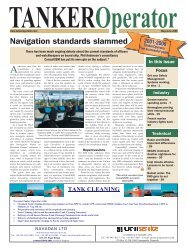Features: Features: - Tanker Operator
Features: Features: - Tanker Operator
Features: Features: - Tanker Operator
Create successful ePaper yourself
Turn your PDF publications into a flip-book with our unique Google optimized e-Paper software.
closed gauging<br />
The HERMetic<br />
UTImeter Gtex is a<br />
portable electronic<br />
level gauge for closed<br />
gas tight operation.<br />
The unit is used for custody transfer,<br />
inventory control measurement and<br />
free water detection on marine vessels.<br />
Connected to a HERMetic vapour control<br />
valve, the UTImeter Gtex avoids<br />
any gas release during operation and<br />
enables 3, optionally 4 measurements<br />
in one single operation, Ullage,<br />
Temperature, Oil-water interface level<br />
and Innage.<br />
We help you to protect the operator<br />
and the environment.<br />
TECHNOLOGY - VAPOUR CONTROL<br />
The absorbtion process shown<br />
schematically.<br />
common inert gas pipe and<br />
deposited at the bottom of one<br />
cargo tank. The system can be<br />
installed in a normal drydocking<br />
and has a payback time of about<br />
six months due to the increased<br />
cargo deliveries.<br />
For ships not engaged in<br />
shuttle trades, a portable solution<br />
for the transfer and loaded<br />
voyage has been devised. This is<br />
where Mariflex comes in,<br />
supplying hardware, power packs<br />
and the operational expertise.<br />
Dr Haagensen pointed out that<br />
sulphuric gases in empty tanks<br />
cannot be removed by using any<br />
on board recovery process.<br />
Odour and H2S concentrations<br />
usually beyond 10 ppm force<br />
ships that have discharged sour<br />
crudes to anchor offshore and<br />
purge their tanks before they are<br />
allowed to load. This timeconsuming<br />
purging can only be<br />
avoided if the ship loads at a<br />
port, which has a large-scale<br />
vapour recovery unit with gas<br />
separation. In terms of<br />
hydrocarbon emissions, offshore<br />
purging only removes the peak<br />
local load of ground level ozone<br />
and by no means negates the<br />
detrimental effects of ozone on<br />
plant growth and their CO 2<br />
uptake capacity.<br />
Having said that, the good<br />
news is that during loading, the<br />
release of H2S is reduced by<br />
20%-40% through the use of<br />
backpressure.<br />
Although the cost of large<br />
vapour recovery processes and<br />
their infrastructure may seem<br />
prohibitive, Venturie regards them<br />
as a final and necessary step to<br />
minimise hydrocarbon and H 2 S<br />
emissions in ports and designated<br />
lightering areas. For such<br />
lightering spots, Dr Haagensen<br />
suggested that port authorities<br />
should consider barge mounted<br />
recovery units, similar to those<br />
installed on the decks of North<br />
Sea shuttle tankers.<br />
TO<br />
For more information visit our website<br />
www.tanksystem.com or call +41 26 919 15 00<br />
© 2008 Honeywell International, Inc. All rights reserved<br />
Time-pressure diagram for an STS transfer with vapour return.<br />
Vapour growth may induce gas release, but vapour reabsorption<br />
will reduce the flow. Controlled gas release is important to reduce<br />
vapour surges from the oil.<br />
28<br />
TANKER<strong>Operator</strong> March 2008

















